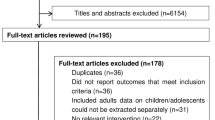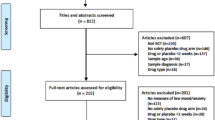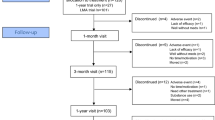Abstract.
Objective:
The aim of this study was to study treatment response to atomoxetine in a large, multicenter study of non-North American patients with ADHD.
Methods:
A total of 604 children and adolescents with ADHD were enrolled in a 10-week open-label trial with atomoxetine prior to randomization to a double-blind relapse prevention phase at 33 sites in the United Kingdom, continental Europe, Israel, South Africa, and Australia. All patients had ADHD symptom severity at least 1.5 standard deviations above United States age and gender norms for their diagnostic subtype as measured by the investigator-scored ADHD Rating Scale (ADHD RS). Outcomes were assessed by analysis of change in the ADHD RS; functional and psychosocial outcomes were assessed using the Child Health Questionnaire (CHQ).
Results:
At endpoint, ADHD RS total scores decreased by an average of 56.7%, and 69% of patients were rated as having no or minimal symptoms. Significant improvement was observed in psychosocial and functional outcomes. Discontinuations attributed to adverse events were < 4%.
Conclusion:
These open-label data, gathered in an international setting, add to our knowledge of the value of atomoxetine in treating ADHD symptoms, as well as its safety and tolerability.
Similar content being viewed by others
References
Allen AJ, Spencer TJ, Heiligenstein JH, Faries DE, Kelsey DK, Laws HF, Wernicke J, Kendrick KL, Michelson D (2001) Safety and efficacy of atomoxetine for ADHD in two double-blind, placebo-controlled trials. Biol Psychiatry 49(suppl 8S):32S–33S (Abstract 114)
Allen AJ, Wernicke JF, Dunn D, Kratochvil C,West S, Casat CD, Harder D, Faries D, Laws HF, Kelsey DK, Thomasson H, Potter WZ, Michelson D (2002) Safety and efficacy of atomoxetine in pediatric CYP2D6 extensive vs. poor metabolizers. Biol Psychiatry 51(suppl 8S):37S (Abstract 109)
American Psychiatric Association (2000) Diagnostic and Statistical Manual of Mental Disorders: DSM-IV-TR. Am Psychiatr Press, Washington, D. C.
Andres Carrasco MA, Catala MA, Gomez-Beneyto M (1995) Study of the prevalence of the attention deficit hyperactivity disorder in ten-year-old children living in the Valencia metropolitan area (Spanish). Actas Luso-Espanolas de Neurologia, Psiquiatria y Ciencias Afines 23:184–188
Biederman J, Spencer TJ (1999) Attention-deficit/hyperactivity disorder (ADHD) as a noradrenergic disorder. Biology Psychiatry 46:1234–1242
Brownell MD,Yogendran MS (2001) Attention-deficit hyperactivity disorder in Manitoba children: Medical diagnosis and psychostimulant treatment rates. Can J Psychiatry 46:264–272
Conners CK (1997) Conners’ rating scales: Revised technical manual.Multi-Health Systems, North Towanda, NY
Faraone SV, Biederman J (1998) Neurobiology of attention-deficit hyperactivity disorder. Biol Psychiatry 10:951–958
Faraone SV, Biederman J, Friedman D (2000) Validity of DSM-IV subtypes of attention-deficit/hyperactivity disorder: a family study perspective. J Am Acad Child Adolesc Psychiatry 39:300–307
Faries DE, Yalcin I, Harder D, Heiligenstein JH (2001) Validation of the ADHD Rating Scale as a Clinician Administered and Scored Instrument. J Attention Disord 5:39–47
Gillberg C, Melander H, von Knorring AL, Janols LO, Thernlund G, Hagglof B, Eidevall-Wallin L, Gustafsson P, Kopp S (1997) Long-term stimulant treatment of children with attention-deficit hyperactivity disorder symptoms. A randomized, double-blind, placebo-controlled trial. Arch Gen Psychiatry 54:857–864
Graetz BW, Sawyer MG, Hazell PL, Arney F, Baghurst P (2001) Validity of DSM-IVADHD subtypes in a nationally representative sample of Australian children and adolescents. J Am Acad Child Adolesc Psychiatry 40:1410–1417
Guy W (1976) ECDEU Assessment Manual for Psychopharmacology, revised. United States Department of Health, Education, and Welfare, Bethesda, MD
Hazell PL (2000) Attention deficit hyperactivity disorder in preschool aged children. Australian Early Intervention Network for Mental Health in Young People, Adelaide
Heil SH, Holmes HW, Bickel WK, Higgins ST, Badger GJ, Laws HF, Faries DE (2002) Comparison of the subjectrated, physiological and psychomotor effects of atomoxetine and methylphenidate in recreational drug users. Drug Alcohol Depend 67:149–156
Hudziak J (1997) The identification of phenotypes for molecular genetic studies of common childhood psychopathology. In: Blum K, Noble E (eds) Handbook of Psychiatric Genetics. CRC Press, New York
Kadesjo B, Gillberg C (2001) The comorbidity of ADHD in the general population of Swedish school-age children. J Child Psychol Psychiatry, and Allied Disciplines 42:487–492
Kanbayashi Y, Nakata Y, Fujii K, Kita M, Wada K (1994) ADHD-related behavior among non-referred children: parents’ ratings of DSM-III-R symptoms. Child Psychiatry and Hum Develop 25:13–29
Kaufman J, Birmaher B, Brent D, Rao U, Ryan N (1996) Kiddie-Sads-Present and Lifetime Version (K-SADS-PL). Version 1.0 of October 1996 ed.The Department of Psychiatry, University of Pittsburgh School of Medicine, Pittsburgh, PA
Kratochvil CJ, Heiligenstein JH, Dittman R, Spencer T, Biederman J, Wernicke JF, Newcorn J, Casat C, Milton D, Michelson D (2002) Atomoxetine and Methylphenidate Treatment in Children with ADHD: A Prospective, Randomized, Open-Label Trial. J Am Acad Child Adolesc Psychiatry 41:776–784
Landgraf JM, Maunsell E, Speechley KN, Bullinger M, Campbell S, Abetz L, Ware JE (1998) Canadian-French, German and UK versions of the Child Health Questionnaire: methodology and preliminary item scaling results. Quality of Life Research: An International Journal of Quality of Life Aspects of Treatment, Care and Rehabilitation 7:433–445
Levy F, Hay DA, McStephen M, Wood C, Waldman I (1997) Attention-deficit hyperactivity disorder: a category or a continuum? Genetic analysis of a largescale twin study. J Am Acad Child Adolesc Psychiatry 36:737–744
March JS, Sullivan K (1999) Test-retest reliability of the Multidimensional Anxiety Scale for Children. J Anxiety Disord 13:349–358
Michelson D, Allen AJ, Busner J, Casat C, Dunn D, Kratochvil C, Newcorn J, Sallee FR, Sangal RB, Saylor K, West S, Kelsey DK, Wernicke J, Trapp NJ, Harder D (2002) Once-daily atomoxetine treatment for children and adolescents with attention-deficit/hyperactivity disorder: A randomized, placebo-controlled study. Am J Psychiatry 159:1–6
Michelson D, Faries DE, Wernicke J, Kelsey DK, Kendrick KL, Sallee FR, Spencer T, and the Atomoxetine ADHD Study Group (2001) Atomoxetine in the treatment of children and adolescents with attention-deficit/hyperactivity disorder: A randomized, placebo-controlled, dose-response study. Pediatrics 108:e83
Miller A (1999) Appropriateness of psychostimulant prescription to children: Theoretical and empirical perspectives. Can J Psychiatry 44:1017–1024
MTA Cooperative Group (1999) A 14-month randomized clinical trial of treatment strategies for attentiondeficit/hyperactivity disorder. Arch Gen Psychiatry 56:1073–1086
Murphy K, Barkley RA (1996) Attention deficit hyperactivity disorder adults: Comorbidities and adaptive impairments. Comprehensive Psychiatry 37:393–401
Poznanski EO, Mokros HB (1999) Children’s Depression Rating Scale (CDRSR) Revised. 2nd ed.Western Psychological Services, Los Angeles, CA
Rohde LA, Biederman J, Busnello EA, Zimmermann H, Schmitz M, Martins S, Tramontina S (1999) ADHD in a school sample of Brazilian adolescents: a study of prevalence, comorbid conditions, and impairments. J Am Acad Child Adolesc Psychiatry 38:716–722
Sachse C, Brockmoller J, Bauer S, Roots I (1997) Cytochrome P450 2D6 variants in a Caucasian population: allele frequencies and phenotypic consequences. Am J Hum Gen 60:284–295
Safer DJ (2000) Stimulant Treatment in Maryland Public Schools. Pediatrics 106:533–539
Seidman LJ, Biederman J, Weber W, Hatch M, Faraone SV (1998) Neuropsychological function in adults with attention-deficit hyperactivity disorder. Biol Psychiatry 44:260–268
Sergeant J, Steinhausen HC (1992) European perspectives on hyperkinetic disorder. Eur Child Adolesc Psychiatry 1:34–41
Spencer T, Wilens T, Biederman J, Faraone SV, Ablon JS, Lapey KA (1995) A double-blind, crossover comparison of methylphenidate and placebo in adults with childhood-onset attention deficit hyperactivity. Arch Gen Psychiatry 52:434–443
Swanson JM, Sergeant JA, Taylor E, Sonuga-Barke EJ, Jensen PS, Cantwell DP (1998) Attention-deficit hyperactivity disorder and hyperkinetic disorder. Lancet 351:429–433
Taylor E, Sergeant J, Doepfner M, Gunning B, Overmeyer S, Mobius HJ, Eisert HG (1998) Clinical guidelines for hyperkinetic disorder. Eur Child Adolesc Psychiatry 7:184–200
Wang YC, Chong MY, Chou WJ,Yang JL (1998) Prevalence of attention deficit hyperactivity disorder in primary school children in Taiwan. J Formosan Med Assoc 92:133–138
Wernicke JF, Kratochvil C, Milton D, Dunn D, Spencer T, Heiligenstein J, Michelson D (2002) Long-Term Safety Of Atomoxetine In Children And Adolescents With Attention-Deficit/Hyperactivity Disorder. Am Psychiatr Assoc New Res (Abstract Book:92) (Abstract NR338)
Author information
Authors and Affiliations
Consortia
Rights and permissions
About this article
Cite this article
Buitelaar, J.K., Danckaerts, M., Gillberg, C. et al. A prospective, multicenter, open-label assessment of atomoxetine in non-North American children and adolescents with ADHD. European Child & Adolescent Psychiatry 13, 249–257 (2004). https://doi.org/10.1007/s00787-004-0401-3
Accepted:
Issue Date:
DOI: https://doi.org/10.1007/s00787-004-0401-3




